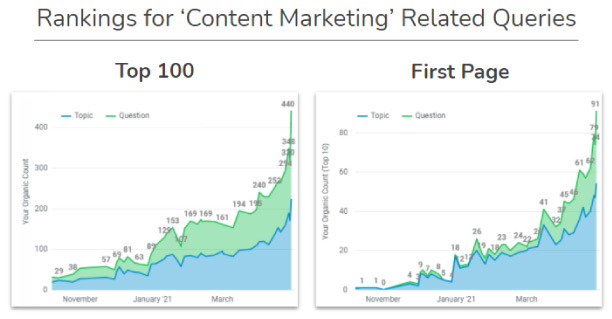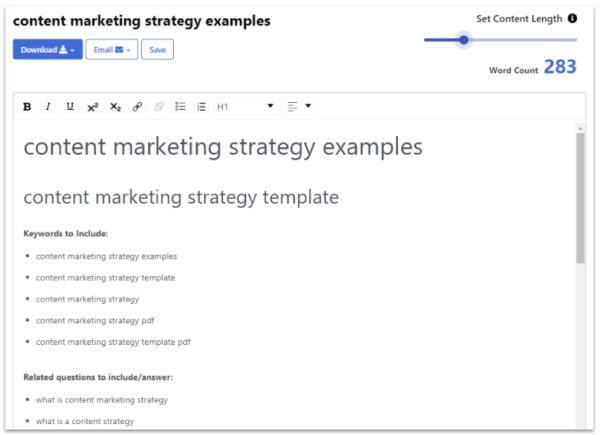91 First Page Search Rankings in Less Than 5 Months: How DemandJump and Metonymy Media Won “Content Marketing” on Google
May 11, 2021 •Ryan Brock

*Update: Since the publication of this blog, DemandJump has acquired Metonymy Media. The results contained in this case study reflect the power of these two organizations joined—and the overall power of the SEO Pillar as the most important marketing tactic today.
If content marketers know anything, it’s content marketing. That phrase—“content marketing”—has become one of the biggest concepts in marketing over the last decade, and for good reason. We all buy differently now than we used to, whether we’re looking to consume for ourselves or for our businesses.
We don’t want to be sold to. We want to do our own research.
Successful brands know this. They’ve embraced the imperative to transform their marketing machines into publishing engines, providing their ideal customers with a wealth of information wherever they happen to be looking for it—primarily on search engines. And marketers have been eager to help. If you would have entered that simple phrase, “content marketing,” into a search engine just six months ago, you’d find some heavy hitters on the first page sharing all kinds of practical information designed to help marketers do better with their content online.
Those heavy hitters? Marketing stalwarts that any good marketer recognizes. Brands like HubSpot. Content Marketing Institute. Neil Patel. CopyBlogger. Marketo.
These are the industry’s top experts on content marketing, so it makes sense that they themselves would be the best at it. For years now, they’ve absolutely owned the first few pages of search results. Ask any content marketer how difficult it would be to catch up and scratch page one on this topic, and you’ll get laughed out of the room.
But if you search that same phrase (or any number of similar topics) right now, there’s a new name that has entered into the page one results seemingly out of nowhere: DemandJump.
That’s because starting in November 2020, my team at the time, Metonymy Media, partnered with DemandJump to write and publish SEO-rich content around the topic. Within 45 days, we earned 221 top 100 Google rankings and 18 first page rankings. We’ve since ranked for 411 top 100 Google result terms and 91 first page Google results - in just five months.
Here’s how.
 Since beginning to publish our “content marketing” pillar in late November 2020, we’ve seen an explosion in rankings around relevant terms.
Since beginning to publish our “content marketing” pillar in late November 2020, we’ve seen an explosion in rankings around relevant terms.
Does Blogging Actually Work?
I’ve run Metonymy Media, a boutique content writing agency in Indianapolis, for 10 years now. In that time, I’ve been asked the same question by countless prospects:
“Does blogging actually work?”
For years, my response would be little more than a waffle; yes, it can work if you are clear on your goals and are committed to the tactic. To earn a significant amount of new traffic from readers who have a good chance of becoming customers, blogging requires consistent publishing and a keen eye for what the search engines want out of content to drive it to the top of results. But my short answer was always the same: We need time to see what works and adjust to the whims of our target audience as we watch them interact with our blog content.
My answer to this question changed radically when I met Shawn Schwegman, CSO and Co-Founder of DemandJump, and he gave me a demo of their platform.
To make a long story short, I was blown away by the tech Shawn had to show me. DemandJump was clearly able to accomplish for my content team what we’d previously needed at least four or five tools to do. By performing quick, AI-driven searches around the topics most valuable to my clients, DemandJump could tell us exactly what our audiences were looking for when they were in a moment of pain. We could get a list of the top keyword phrases and the questions people ask when they face an obstacle they need help clearing.
More than that, we could see the entire customer journey for the current competitive landscape. What websites did our best customers visit at each stage of the funnel? Where did they end up making a purchase? How are our competitors ranking for different terms? And which ones do we have the best opportunities with?
Over the course of six months, we built a strong relationship with DemandJump because it worked. Every client we brought to the platform saw marked increases in rankings and traffic. No longer were we just guessing where to start blogging with a new client; we had a clear roadmap to follow to the results we wanted.
So when Shawn came to me with an idea to take on maybe the single most difficult topic to win on Google—“content marketing”—I’d seen enough to believe we might actually be able to do it.
Building an SEO Pillar Blueprint
Shawn and his team are absolute geniuses when it comes to data. Not just collecting it like so many other tools can do, but interpreting it to build actionable content campaigns that will result in page one results.
The best way to organize a campaign? The SEO pillar approach.
For those who aren’t familiar, the pillar approach to SEO involves building interconnected webs of content around specific topics. Short-tail keywords like “content marketing” become the titles of “pillars,” which are 3,000-word-plus blogs or webpages that act as comprehensive overviews of the topic.
Under each pillar, there are a series of “sub-pillars” on slightly longer tail terms like “content marketing strategy” and “content marketing examples.” These are also on the longer side, around 2,500 words, and they take a more focused dive into different aspects of the main topic.
Supporting both the pillars and sub-pillars are a short series of “supporting blogs” about 750 words a piece. Many of these articles have titles in the form of the most commonly asked questions about a subtopic. For example, under “content marketing strategy,” we might include blogs like:
- How Do You Write a Content Marketing Strategy?
- What is a Content Strategy?
- What are the Types of Content Marketing Strategy?
From there, the trick is to interlink in a way that sends the right signals to search engines about the flow of content. A supporting blog only links up to its matching sub-pillar, which then only links up to the main pillar. Anywhere a reader might come into the web, there’s always a next step for them to dive deeper into the topic with bigger pieces of content that offer even more insight.
When I spoke with Shawn and Drew Detzler, DemandJump’s Director of Marketing and Analytics, they came loaded with an entire pillar plan based on the insights they gained from their own platform. By starting with the broadest topic—“content marketing”—they were able to run deeper and deeper consumer insights reports and uncover those supporting sub-pillars and blogs that Shawn likes to call “table stakes.” Without these pieces of content, we’d have no hope of getting noticed by Google and start inching up towards page-one placements.
 DemandJump prioritizes keywords and questions based on things like search volume and competition to provide a “DJ score” ranking the value of a given term. Terms with a 100 DJ score are the most valuable, and anything over 80 is going to move the needle.
DemandJump prioritizes keywords and questions based on things like search volume and competition to provide a “DJ score” ranking the value of a given term. Terms with a 100 DJ score are the most valuable, and anything over 80 is going to move the needle.
The plan for this particular topic was a big one:
- 1 main pillar
- 16 sub-pillars
- 72 supporting blogs
Not every topic demands this volume; many of my own clients have seen great success with smaller pillar campaigns of, say, six or seven sub-pillars with three supporting blogs for each.
Another factor in scoring the SEO value we wanted out of this campaign was time. Some topics can have pillar campaigns spread out over 2-3 months and succeed, but we knew this one would require a lot of content quickly.
So we did what only insane people would do: We decided to write and publish all of this content in a span of just six weeks.
Writing Content for Humans—and Search Engines
With all the analytical heavy lifting done and the plan in place, it was time for my team at Metonymy Media to start the creative work. It might be easy for some marketers to look at that volume of content and tap a freelancing website to farm it all out to the lowest bidder and get the content written as cheaply as possible. But we knew that would never be good enough.
Why not? Because the job here isn’t just to write for search engines—it’s to write for the humans that use them. Google has spent the last decade perfecting its technology to make SEO a game that can’t just be won with simple tricks. Google looks at how real people interact with content to gauge its quality and relevance. It’s no longer enough to spam a blog post with keywords and hope to win. The content itself, all the way down to those shorter supporting blogs, needs to be something people will actually find value in. It needs to meet them where they are in their pain and provide immediate, practical relief from it. It needs to entertain, to resonate emotionally.
It needs to do what no algorithm can.
I believe Metonymy Media has survived and thrived through the last decade of digital marketing evolution because we’ve always viewed the latest technology as a mere tool to connect with our audiences. We only hire professionals who have degrees in creative writing because those writers come to the table with a lot you just can’t teach on the job: how to write in voices that aren’t their own, how to quickly spot reliable research sources, and how to collaborate with others to make every piece as good as it can be.
The magic is in matching the right-brain creative approach with the left-brain organization that comes from Shawn and the team at DemandJump, and that’s exactly what we did.
For each article in this pillar campaign, our writers spent a considerable amount of time in DemandJump’s platform taking a closer look at those questions and keywords people search for around every topic. From a management perspective, we provided each writer with an “outline” generated by DemandJump and curated by me to focus only on the most relevant terms and questions to answer.
 With DemandJump’s outline tool, content marketing managers and writers can generate topics and edit them right within the platform to guide the creative process.
With DemandJump’s outline tool, content marketing managers and writers can generate topics and edit them right within the platform to guide the creative process.
Those outlines provided writers with a set of tools to use in drafting a piece: A question that’s perfect for a section H2. A keyword phrase that fits organically into a paragraph. Fitting those elements together in a way that flows and still gives a writer legroom to be creative and tell a compelling story is what makes the pillar approach driven by DemandJump actually work.
We broke the whole pillar into six weekly batches, which we delivered to Drew at DemandJump to publish at the end of each week. From there, they were able to quickly drop the content into their CMS, format, add images and those all-important links between pieces of the pillar, and publish.
All that was left to do was watch the results come in, and it was quickly clear that our work had not been in vain. Here’s how easy it is:
SEO Success Requires the Whole Human Brain
Earlier I referenced the convergence of my right-brained writing team with DemandJump’s left-brained data analysts. This (completely bunk) way of thinking about the human brain is one I’ve leaned on a lot in my career as a content marketer. I’ve even gone so far as to make a presentation called “About Three Pounds” a part of my regular conference circuit as a way of communicating how critical it is that content marketers leverage the whole human brain—all three pounds of it.
At this point, I can’t think of a better illustration of that maxim than this project. We found a way to bring the creative and the analytical together in a way that simply works, and the best part is it just keeps getting better. The farther away from that initial six-week launch we get, the more our rankings continue to skyrocket. We continue to add supporting blogs into the mix to keep the “content marketing” pillar fresh, and we’ve effectively established the DemandJump brand as a bonafide authority on the topic online.
So next time someone asks me that loaded question—“Does blogging actually work?”—all I have to do is send them a link to this case study.
If that’s not valuable, I don’t know what is.
Try the DemandJump platform for yourself for FREE, and start creating content that ranks today!
Featured Articles
Categories
- Attribution Tracking (13)
- Channel Optimization (11)
- Consumer Insights (68)
- Content Marketing (251)
- Data Science (8)
- Digital Marketing (6)
- Digital Transformation (26)
- Enterprise (10)
- Lead Generation (14)
- Market Intelligence (8)
- Marketing Analytics (39)
- Marketing Attribution (57)
- Marketing Management (153)
- Marketing Operations (86)
- Organic Search (222)
- Paid Search (52)
- Pillar-Based Marketing (63)
- Programmatic Advertising (9)
- SaaS Content (14)
- SaaS Marketing (29)
- Search Marketing (111)
- SEO Keyword Research (28)
- SEO Pillar (18)
- SEO Strategy (46)
- SMB (5)
- Website Content (12)


